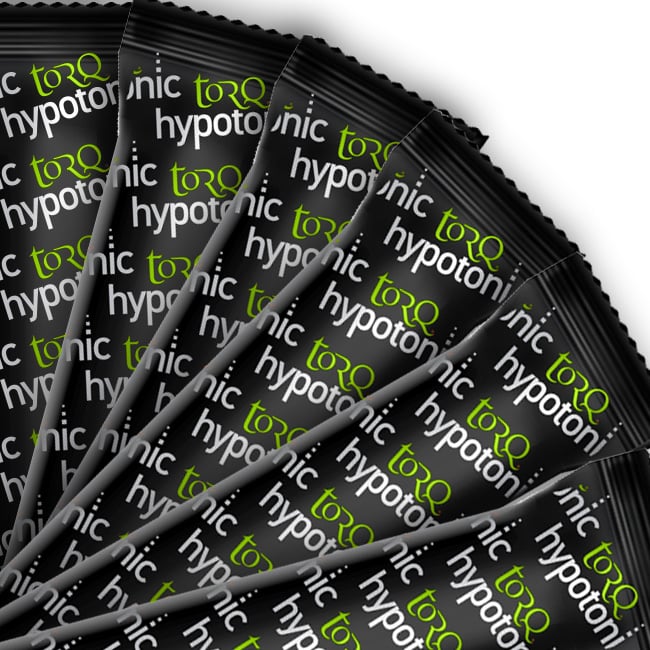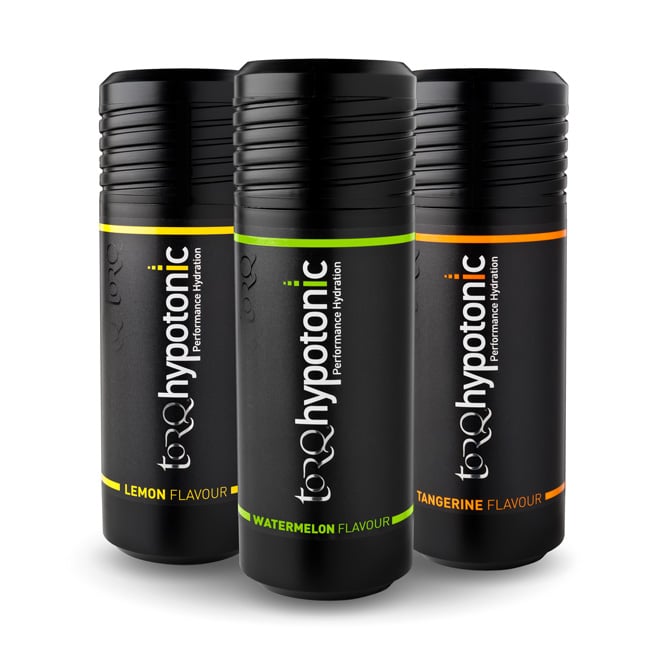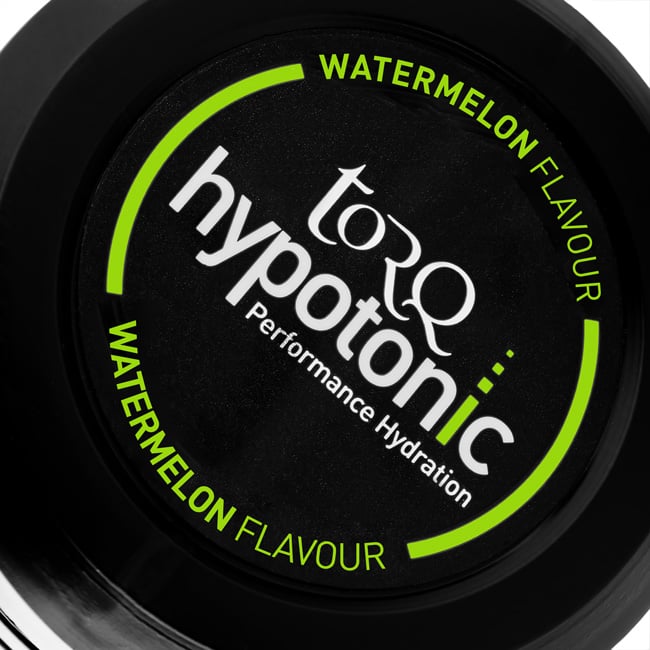The annual CORE Bike Show for the cycle trade opens this Sunday and we’re excited to be launching our brand new naturally flavoured Watermelon Hypotonic hydration drink.
Last year we launched the very popular light-bodied and subtle Lemon and Tangerine flavours, so we’ve followed on with our most mellow hypotonic yet. TORQ Hypotonic has been designed to optimise fluid and electrolyte delivery over any other factor. The drink is sold in a handy plastic screw-top canister containing 6 X 18g hypotonic sachet/sticks. Each stick mixes with water to make a 500ml drink, specifically aimed at hydration and optimal where events/sessions are no more than an hour long and heavy sweat loss is anticipated.
TORQ Hypotonic can also be used as part of the TORQ Fuelling System during longer events and the handy 6-pack makes carrying your drinks very easy, as it slips nicely into the rear pocket of a cycle jersey or sports bag.
Each hypotonic stick contains only 15grams (0.5 TORQ Units) of carbohydrate, so is very light on calories (60 Kcals per 500ml), which means that achieving optimal fuelling for longer durations using this product alone is literally impossible as it would require consuming 2-3 litres of fluid! It is therefore essential that you read and understand the TORQ Fuelling System and consume enough of TORQ’s solid fuelling units (TORQ Gel, TORQ Bar and new TORQ Chew) if you are going to use TORQ Hypotonic as a means of hydration during extensive endurance sessions.

Our advice for longer efforts, where fuelling is required as well as hydration, is to use TORQ Energy as your drink source, because the isotonic nature of this product will provide a better balance between fuelling and hydration – that said, the choice is clearly yours, as long as you understand that your goal in the endurance scenario is to consume 2-3 TORQ Units per hour. Some people will prefer the lighter flavour and mouthfeel of TORQ Hypotonic, and that’s fine as long as you understand the rules!
Essentially, where TORQ Hypotonic is designed to excel is during intense indoor sessions where perspiration rates are high, but efforts don’t exceed an hour in duration. A canister sitting in your gym bag at all times is where this product wants to be, or next to your turbo or treadmill if you’re lucky enough to have one at home. Short criterium bike races or competitive 10k runs make perfect sense too, if you’re in a position to have someone pass a bottle up to you.

For any drink/solution to be effective in hydrating us, it must be rapidly absorbed into the body. One of the main factors affecting how quickly solutions are absorbed is the speed at which it can move across the wall of the small intestine and into the blood stream. Fluids are absorbed into the body almost exclusively in the small intestine, via two main mechanisms; passive transport, and facilitated transport.
Passive Transport: Here water moves across the small intestine as a result of an osmotic gradient, which is a result of a pressure difference between the solution in the small intestine and blood stream. Water molecules move across semi permeable membranes (the intestinal wall) through channels called aquaporin’s. The animation below demonstrates the passive transport process:
[embedyt] https://www.youtube.com/watch?v=0v_ckltdkcM[/embedyt]
Facilitated Transport: Water can also enter the body in the small intestine as a result of the absorption of carbohydrate and sodium, through the process of cotransport. Carbohydrates, such as glucose, are absorbed into the body via a specific transporter called sodium-glucose cotransporter 1, or SGLUT1 for short. These transporters act as a conveyor belt for glucose and sodium, moving them across the small intestine without the need for an osmotic gradient. As carbohydrate and sodium is moved through the SGLUT1 transporter, it also drags with it large volumes of fluid, significantly assisting in hydration. For every single glucose and 2 sodium molecules that is moved by SGLUT1, 260 water molecules are moved with it (Loo, Zeuthen, Chandy, & Wright, 1996: Reference 5). The animation below demonstrates the facilitated transport process working in conjunction with passive transport:
[embedyt] https://www.youtube.com/watch?v=B1T5EF7TKUw[/embedyt]
A hypotonic solution represents the fastest possible way to hydrate: In situations where perspiration rates are extremely high over short periods of exercise (up to 60 minutes), including indoor turbo/gym interval sessions, spinning classes and short competitions in extreme heat, hydrating with TORQ Hypotonic will deliver superior performance over any other fuelling/hydration strategy.
A hypotonic solution offers significant benefits over electrolyte tablets: We have been particularly vocal on this website about the misselling of electrolyte tablets for a variety of reasons. Please take the time to click HERE to read our very popular article. In summary, we complained about the fact that these tablets don’t do what the user might perceive they’re going to do. They contain ZERO carbohydrate, so can only provide a passive transport mechanism for hydration. As demonstrated above, carbohydrate is required to engage facilitated transport.
The fact that electrolyte tablets contain no carbohydrate means that they need to be artificially sweetened, which we at TORQ are heavily opposed to. They also contain effervescent agents, which aren’t required if the drink is supplied as a powder rather than a tablet. Many drinks, including these tablets, also contain colours, which we also refuse to entertain at TORQ.
Our main complaint about the marketing of electrolyte tablets was and still is that zero carbohydrate means zero fueling benefit and this isn’t being made clear to customers in our opinion. TORQ Hypotonic contains 15g of multiple-transportable carbohydrates (60 Kcals) per serve, which we make abundantly clear isn’t enough to optimally fuel longer performances (one would need to drink 3 litres of it to fuel optimally) – it is however a lot better than zero carbohydrate.

In summary, electrolyte tablets won’t hydrate you very well, or fuel you at all, and contain sweeteners, so what do they actually do? If hydration is your overriding goal, use TORQ Hypotonic, because it will achieve what you need it to. If you are exercising for longer than an hour, or have a heavy training schedule, consult the TORQ Fuelling System and choose products that are appropriate to your objectives. You can always pick up the phone and talk to us if you’re confused, it’s all part of the service we offer.
Pure Water: In case you were wondering, pure water is a particularly poor hydrator. Plain water causes bloating due to poor absorption and also suppresses the thirst reflex, leading to decreased desire to drink. It also stimulates urine output and is therefore, inefficiently retained within the body. The carbohydrate and electrolytes in TORQ Hypotonic overcome all of these problems.
Multiple-Transportable Carbohydrates: TORQ Energy utilises a 2:1 blend of glucose-derivatives and fructose founded on a now substantial body of peer-reviewed published research (see bottom of this page for details). The carbohydrate sources for TORQ Hypotonic come from dextronse (2 glucose molecules bonded together) and fructose. This dual-delivery carbohydrate formulation has been proven beyond doubt to supply energy faster than any other combination of carbohydrates or single carbohydrate source formulations. Take a look at the two very short movie clips below, which demonstrate how 2:1 Glucose-Derivatives:Fructose deliver over 40% more carbohydrate to the blood per hour than single glucose sources (the next best option).
[embedyt] https://www.youtube.com/watch?v=-0MYQrPdnVc[/embedyt]
[embedyt] https://www.youtube.com/watch?v=BuIO-u-vegw[/embedyt]
If you would like further information on this product, click HERE or phone us on 0344 332 0852. To purchase TORQ Hypotonic, you can visit our online shop by clicking here.





